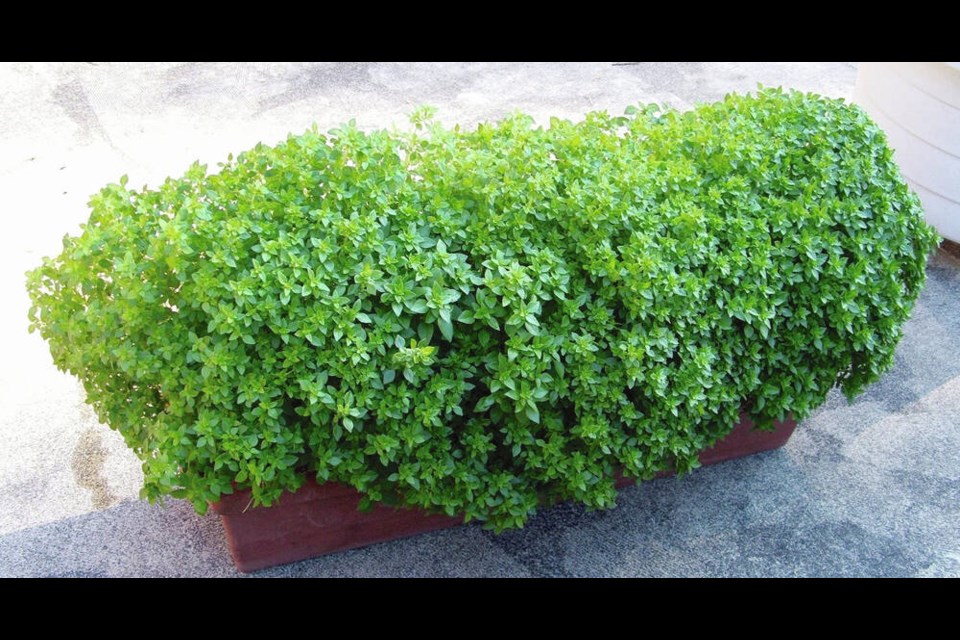Dear Helen: Do you still grow dwarf basil plants that form neat miniature hedges in window-box type planters? What variety or varieties make the most visually appealing plantings with flavourful little leaves?
L.C.
I have a longstanding habit of growing four of these dwarf, small-leaved basil varieties of the Green Globe type, each in its own planter on shelving against the south side of the house. The plantings deliver a plentiful supply of basil leaves over the summer and early autumn. And they offer the opportunity to compare them, with a view to choosing the best ones to grow in the following year.
It is difficult to recommend specific varieties because of the frustration in recent years of discovering ones that are superior only to find them disappearing from all the plant lists I normally use. Pluto and Pistou are examples.
Of the four I grew this year, a variety called Greg, from William Dam Seeds, was the most compact, nicely shaped, and long-lasting. It was still producing useable foliage when the others had begun to blacken and shrivel in less than cozily warm temperatures.
Spicy Globe, one of the older varieties, like Green Globe, was the next best variety. Seed for this variety will be available from a number of sources in plant lists that will soon be available. Companies currently listing it are Ontario Seed Company (OSC) and Renee’s Garden in California — a rich source of container varieties.
Brother Nature Seeds in Victoria lists Sweet Dwarf Greek basil, which I’ll be trying next year. The plants are described as compact domes of small, pungent leaves. Most sources cite the plant height as around 20 cm.
Richters herbs in Ontario usually lists both Green Globe and Greg.
Dear Helen: I am keen, this autumn, to get as much tidying and trimming done so that, with spring, I can get on with the planting in a garden in generally good shape. Right now I am wondering about the roses. Many need pruning. Can I safely prune them now? I have several climbers as well as bush roses.
C.N.
The best timing depends on the type of rose. Leave the main pruning of bush roses until late winter, ideally as growth buds show the first signs of swelling. Restrict pruning in the fall to shortening over-long canes prone to being whipped about and damaged or broken in winter winds.
Among climbing roses there are two main types. Ramblers and climbing old roses that flower only once, most commonly in June, are pruned after flowering, in July. They flower mainly on the previous season’s growth. Pruning consists of removing some of the oldest (thickest) canes and shortening remaining canes enough to keep the plant in bounds.
I prune my repeat-flowering modern climbers in late autumn, starting with the removal of the oldest canes. I arrange and secure the remaining canes to the support in a fan shape, as close to the horizontal as possible for best flowering, and shorten them to fit the support. Side shoots off these main canes are shortened to leave just two or three buds.
By December, remove all rose leaves still clinging to the plants. Clean up well under and around the plants and plan to mulch early in the spring.
Dear Helen: I have cabbage, kale, winter broccoli, Brussels sprouts and root vegetables in the garden. What should I be doing to prepare them for winter conditions?
S.F.
Stake any tall plants like Brussels sprouts and purple sprouting broccoli that could fall over in heavy winds. Clear the plants of discoloured foliage and mulch them with fluffy leaves or chopped straw. Clean root vegetable plots and mulch with a five-cm layer of garden soil to protect the carrot, beet, parsnip and winter radish root tops against frost damage.
Have old floating row covers, tarps or sheets of plastic available for covering winter vegetables if heavy frosts are predicted. Pile leaves or straw around the plants first, if possible. Three layers of floating row cover saved my radicchio plants a few winters back.
GARDEN EVENT
Mid Island floral arts. The Mid Island Floral Art Club will meet on Thursday, Nov. 14, at 2 p.m. in St. Stephen’s Church, 150 Village Way in Qualicum Beach. The afternoon will feature a Christmas themed design using Texture: Demo & Create. Information at 250-757-8969 or [email protected].



